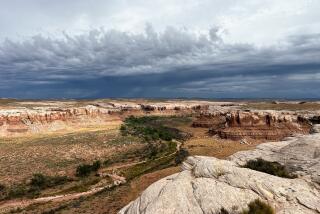Opinion: The Amazon forest isn’t the only one in peril. Trump has his eye on Alaska
In the faraway Amazon, politics and commercial exploitation are fueling fires that threaten the world’s largest tropical rainforest. Closer to home, in Alaska, the Tongass National Forest, which represents the largest intact temperate rainforest, is facing a serious threat of its own: President Trump’s determined rollback of environmental protections. In both cases, land belonging to all citizens is at risk because of the financial ambitions of a few.
According to a report in the Washington Post, Trump has ordered Agriculture Secretary Sonny Perdue to change Forest Service policy and open more than half of the Tongass — 9.5 million acres — to the construction of new roads, effectively encouraging development such as large-scale commercial logging of old growth trees.
The Tongass covers a huge area of the Alaskan panhandle. It is largely undeveloped, it’s a carbon storehouse and it’s a fish factory. The Forest Service reports that the Tongass produces 25% of the West Coast’s commercial salmon catch. Fishing and tourism, which depend on a healthy forest, bring in more than $2 billion to Alaska annually by one estimate. They account for 26% of local jobs; logging accounts for less than 1%.
The president’s directive would undo 20 years of relative stability on the Tongass that was created by the enactment of the Roadless Area Conservation Rule in 2001. As former Forest Service employees, we helped to develop the roadless rule. Understanding its context is important to understanding the threat to the Tongass today.
In the late 1990s, before the roadless rule went into effect, the Tongass and other remote forests were the subject of constant controversy and litigation over timber sales and road construction. As is still the case, timber sales on the Tongass lost money and were heavily subsidized by U.S. taxpayers. Adding insult to injury, much of the wood that was harvested was shipped across the ocean to Asia.
By 1998, the Forest Service had constructed more than 380,000 miles of roads in the national forests, largely to aid timber production. The agency also carried an $8.5-billion maintenance backlog on management of those roads. When forest roads are not maintained, they erode and slide into streams, muddying drinking water sources and ruining fish habitat.
Many inside the Forest Service and in Congress rightly began to question why the agency would build more roads into relatively pristine areas when it could not take care of the roads already in place. Lawmakers rebelled. As a surrogate to protect roadless areas, in 1997, the House of Representatives came within a single vote of cutting the Forest Service’s road budget by 80%. This would have crippled the agency and jeopardized public access and use of the national forests. President Clinton stepped in, directing the agency to develop a new policy for managing untouched forests.
The result was stronger protection of roadless areas. More than a million people commented on the proposal, and more than 90% favored keeping new roads to a minimum in pristine forests. The final rule allowed for new road construction on a case-by-case basis, for firefighting, forest health, energy development and access to private holdings, but it seriously restricted new timber sales. Since the rule was enacted, the Forest Service has approved all 58 project requests it has received for roads in Alaska’s national forests.
Nevertheless, Alaska’s congressional delegation and its governor, pushed primarily by logging interests, wan an exemption from the roadless rule. But decisions that affect our shared land shouldn’t be made at the behest of special interests. They should be made by professional land managers and informed by science — not politics.
The roadless rule has served our national forests well. It affirms a basic truth. Most Americans value their public lands for the clean water, healthy habitat and recreational opportunities they provide. Over a century ago, President Theodore Roosevelt’s secretary of Agriculture, James Wilson, wrote that national forests should be managed for “the greatest good for the greatest number for the long run.” We urge the president and Secretary Perdue to follow this sage advice and do what is best for the long-term health of the land and future generations of Americans.
Mike Dombeck was chief of the U.S. Forest Service from 1997 to 2001. Chris Wood is the president and chief executive of Trout Unlimited.
More to Read
A cure for the common opinion
Get thought-provoking perspectives with our weekly newsletter.
You may occasionally receive promotional content from the Los Angeles Times.










